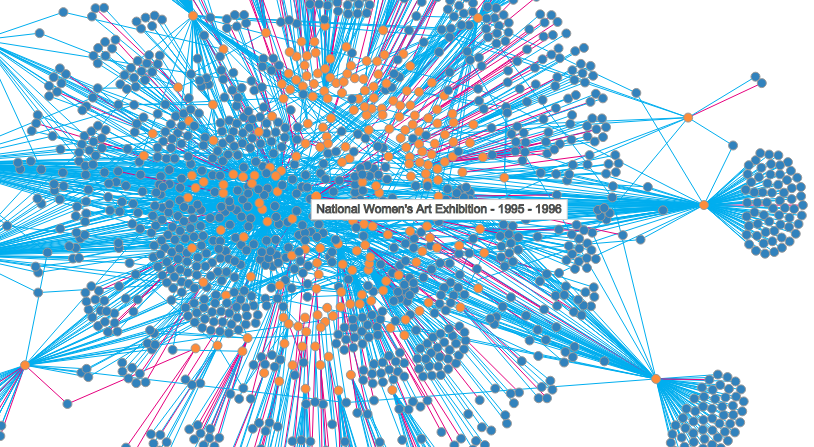Posted by
oliviabolton on Wednesday, November 11th 2015
DAAO’s current brief to enable next generation e-Research in Australia’s visual and design cultures has led us to spend a lot of time looking at how DAAO data can be re-interpreted through data visualisation. We’ve run a number of visualisation proof-of concept projects to help us understand the potential and limitations of DAAO’s data.
For one of these projects, we partnered with Contemporary Art & Feminism at Sydney College of the Arts to develop a couple of visualisations of ‘The National Women’s Art Exhibition’ (1995), a series of independent shows held in over 150 venues in 1995 to commemorate the 20th Anniversary of the International Women’s Year.
Eric Riddler worked his magic to pull in all of the event and person data that wasn’t already present on DAAO to ensure we were working with a comprehensive subset of data. Gillian Fuller worked with CAF cohort Jo Holder, Catriona Moore and Jacqueline Milner to define a series of research questions we’d need to be able to explore through visualisation. For example, what percentage of curators/artists were indigenous Australians, can we see an increase in exhibiting activity for the artists in the 1995 events, and were some artist more represented in the events than others?
Our developer
Alastair Weakley @ IC then played with a number of visual representations of the data that would help us address those research questions. Alastair also made a generic version the main visualisation so we could apply it to any other DAAO event.
It has been rewarding to see how visualisation can offer new entry points to DAAO data. It’s also given us a great insight into the kinds of refinements we might need to make to the schema in order to respond to more complex questions. And, importantly, all of our visualisation PoCs have been a reminder that enabling researchers to use DAAO data for visualisation is not just about making the data accessible or making sure the schema is ‘right’, its about providing comprehensive data.
For info on other work DAAO is doing with CAF, see the
Future Feminist Archive, a gateway to Australian Feminist art.

